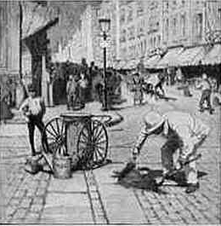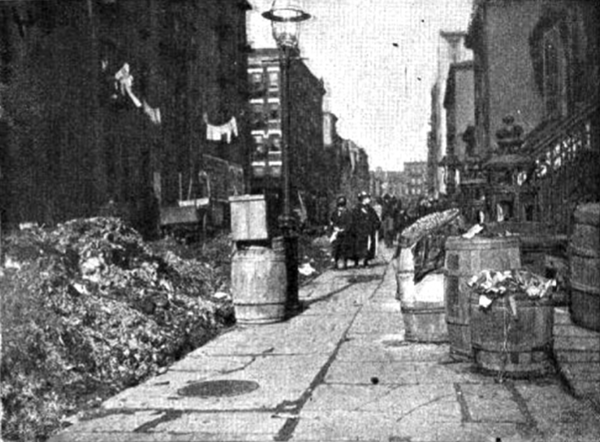In 1898 the first international urban planning conference convened in New York. One topic dominated discussion: manure. Cities all over the world were experiencing the same problem. Horses were a staple of 19 -century cities: all transportation, whether of goods or people, depended on them. London, for example, had 11,000 horse-drawn cabs; several thousand buses, which required 12 horses per day, added an extra 50,000 horses; and a large number of carts, drays, and wains, which were constantly making deliveries, added an immeasurable amount of extra horses to the streets daily. On average, a horse can produce from 15 to 35 pounds of manure and around 2 pints of urine per day – which leaves New York city alone dealing with 2.5 million pounds of horse manure per day. And London wasn’t better off, either.
Unable to see any solution to the manure crisis, the delegates abandoned the conference after three days instead of the scheduled ten days. It was made clear to all attendees that they were dealing with a persistent, waste management nightmare; the bigger and richer the cities became, the more horses they needed to function. Rises in living standards drove demand and consumption of more goods, products and amenities, which in turn necessitated more horse drawn transport. In 10 major US cities, the equine population rose by 328%, whereas the population increased by 105%. In turn, the rising number of horses led to more stables, more land, more food and eventually more manure. Not to mention that when these overworked horses would die in the streets, their carcasses were often left there until they began to putrefy. The manure and decomposing horse carcasses that lined the city streets attracted flies and helped spread typhoid fever and other diseases. One writer in the Times of London predicted; “In 50 years, every street in London will be buried under nine feet of manure.”
Participants had hoped to hammer out a solution to the horse problem and its smelly attendant consequences, but instead, seeing no way out of the morass, they disbanded and went home in frustration. Albeit living in a transitional period, the world’s top urban planners weren’t exactly wrong to abandon their posts; any step against horses would essentially challenge the basic means of transporting people, goods and any type of cargo, which consequently meant the conference had to challenge the whole business model in its core.

Few years later, not only the horse manure apocalypse was prevented, but horse transport itself became nonessential – and they had Henry Ford and mass car production to thank for the twist. When Ford created a new way to produce motor cars at affordable prices, cars, electric trams and motor busses began appearing on the streets, replacing horse-drawn buses for good. Horses began to be phased out of daily life. As prices for hay, oats and land rose, and fears of horse pollution became more urgent, the masses began to adopt the fledgling technology.
By 1912, the number of cars on New York City’s roads had surpassed the number of horses. Buyers found cars to be cheaper to own and operate and much more efficient—not to mention more sanitary. The once-essential horse came under fire from magazines like Harper’s Weekly and Scientific American, which praised the automobile for its economic sustainability and ability to reduce traffic. The second industrial revolution opened the way for the third one; the era of mass car production that electrification had permitted. Ford had drastically reshaped urban life by introducing the modern car, along with a new production scheme. This was not brought about by regulation or by government policy. Instead, it was technological innovation that made the difference. With electrification and the development of the internal-combustion engine, the horse manure crisis was solved once and for all.
As we are living in the era of the Fourth Industrial Revolution, as we live the transition towards a new economic paradigm that will transform radically all the industrial sectors (and certainly it will wipe out some of them), the horse manure crisis must be discussed in detail. Because the story demonstrates three major issues.
First, some of the most important problems we face in waste management it’s not possible to be resolved by simply optimizing the current system. They will be resolved only by radical technological innovation, and the solutions that will be offered might be unimaginable even for the best waste management experts. Take the example of e-waste – if the robotic solutions in place will be as effective as they seem to, after some years we will have eliminate e-waste, in most of the countries of the world.
Second, waste management problems are interwoven within the structure of the economy and the daily habits of people. Therefore, trying to find solutions to serious waste management problems (e.g. hazardous waste in Africa, Marine Litter) is impossible in the narrow view of waste management – you have to address and influence the economic and social patterns first, and then maybe you can tackle waste management problems.
Third, the solution to the horse manure crisis did not arrived from the horse and carriage experts, not even from the sanitation experts. It came from a completely different sector, that typically kept the wheels of the carriages and changed all the rest elements, including the business models. It came from the invention of a new product and a new ecosystem between citizens, industries, transportation companies etc.
I believe that all the previous are very important lessons for our era, and we have to think deeper our current “horse manure crises” and how they will be resolved by the Fourth Industrial Revolution. But this is just a starting point, in my next blog post, I will continue about it.






Good job Antonis. That’s exactly the point! To much Urban Planners thinks they are in charge to find solutions to City problems because they don’t understand that Urbanization is a matter of organined complexity that comes from economic patterns and social behaviors. The same, as you pointed, is for waste management. All is interconnected and only new disruptive technologies, solutions and transvergent knowledge and points of view will help us to face contemporary challenges.
There needs to be an economical paradigm shift away from GDP growth towards life quality indicators. Models such as the circular economy are at odds with demands on GDP growth. Circularity is possible and achievable today but without a new economical model- it will remain a dream.
Great article Antonis, as usual your view points are so well put.
Great article by president and man who see the wasteless future. Thank you so much.